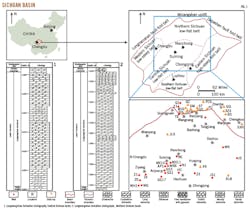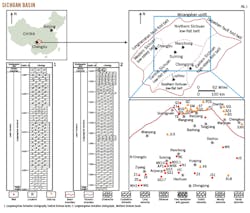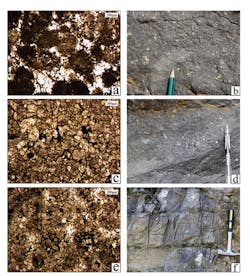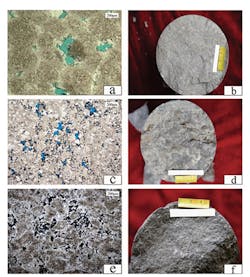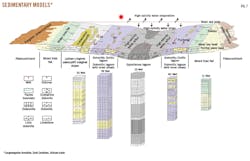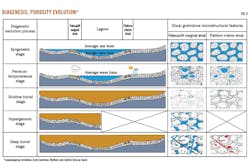Analysis reveals Longwangmiao porosity, permeability differences
Longbo Xu
Southwest Petroleum University
Chengdu, China
Analysis reveals regional differences in the Longwangmiao formation’s granular shoal. Reservoir porosity and permeability of Longwangmiao formation in northern Sichuan basin is worse than that in central Sichuan basin.
During the Early Cambrian Longwangmiao period, the northern Sichuan basin was near the Hannan paleocontinent, hydrodynamic force was weak, and deposition contained lots of quartz and muds.
The central Sichuan basin was near the Leshan-Longnvsi paleo-uplift, away from the Kangdian paleocontinent provenance, and the uplift blocked the paleocontinent’s land-based debris and clay mud. As a result, the eastern wing of the Leshan-Longnvsi paleo-uplift deposited large granular shoals. The granular shoals contained few terrigenous debris. Lacking hypergenesis in northern Sichuan basin, dissolved pores were undeveloped.
Background
Cambrian Longwangmiao formation is one of the main producing reservoirs in Sichuan basin. The large, monoblock Anyue gas field lies in the Weiyuan-Gaoshiti area of the basin.1-2 Much research has been done on granular shoal characteristics, dissolved pore and dolomitization mechanisms, reservoir characteristics, and favorable reservoir distribution for Longwangmiao formation in central Sichuan.3-17
Growing demand for oil and gas has prompted a search for other favorable zones. The difference between the Longwangmiao formation granular shoal in northern Sichuan basin and that in central Sichuan basin has drawn particular attention. This article focuses on the differences between the two locations and discusses factors controlling distribution of reservoirs in Longwangmiao formation to provide a reliable geological basis for subsequent exploration and development.
The study area lies mainly in Northern Sichuan low-flat belt, Central Sichuan low-flat belt, and partially in Micangshan uplift. The Cambrian Longwangmiao formation is mainly distributed in the Weiyuan-Gaoshiti area in Central Sichuan basin and distributed along the Guangyuan-Zhenba area in Northern Sichuan basin (Fig. 1).
During the early Cambrian Longwangmiao period, the Sichuan basin formed a thick carbonate deposit. Longwangmiao formation, together with the overlying Douposi formation and underlying Canglangpu formation, forms a continuous sedimentary sequence.18 The main lithology of Longwangmiao formation in the central Sichuan basin is granular dolomite, fine crystalline dolomite, and mud-crystalline dolomite (Fig. 1). The main lithology of Longwangmiao formation in the northern Sichuan basin is dolarenite dolomite, limy dolomite, and crystalline dolomite with some terrigenous clastic (Fig. 1).
Experiments
More than eight wells targeted to Longwangmiao formation recovered cores in the study area consisting of 10 outcrops in Sichuan basin. Investigation of reservoir characteristics of Longwangmiao formation used more than 149 dolomite samples from wells cores and outcrops, analyzing them in thin section for routine physical property as well as applying scanning electron microscope (SEM) and cathodoluminescence emission analysis.
Samples polished to 0.03 mm thick underwent finishing at State Key Laboratory of Oil and Gas Reservoir Geology and Exploitation, Southwest Petroleum University. Porosity and permeability characteristics of Longwangmiao reservoir were obtained by routine physical analysis of 80 samples. Subsequent testing occurred at State Key Laboratory of Oil and Gas Reservoir Geology and Exploitation, Chengdu University of Technology.
Reservoir petrology in the Longwangmiao formation, Lower Cambrian in the Northern Sichuan basin shows (a) Dolarenite dolomite, Longwangmiao formation, Well MS1; (b) Dolarenite dolomite, Longwangmiao formation, Shatan; (c) Powder crystalline dolomite with some intracrystalline pores, Longwangmiao formation, Well TX1; (d) Oolitic dolomite, Longwangmiao formation, Nanzheng; (e) Dolarenite dolomite, Longwangmiao formation, Well Z1; (f) Crystalline dolomite, Longwangmiao formation, Bashan (Fig. 2).
Lithological characteristics
The lithology of the Lower Cambrian Longwangmiao formation in central and northern Sichuan basin consists of dolarenite dolomite, oolitic dolomite, and crystalline dolomite. Dolarenite dolomite is one of the main reservoir rocks in the study area.
The northern Sichuan basin contains mostly meso-thin or lenticular deposits, with gray to light gray coloring (Fig. 2a), 50-65% dolarenite, 10-20% terrestrial clay and debris quartz, granular size of 0.16-0.40 mm, and poor sorting and psephicity (Fig. 2e). Intergranular dolomite cementing fill and selective dissolution of granular content and cements forms a small amount of intergranular dissolved pore with a surface porosity of 1-3% (Fig. 2b).
The dolarenite dolomite in the central Sichuan basin is medium-thick layered deposition, mainly gray-light gray color, dolarenite content of 50%~80%, granular size of 1-1.5 mm with good sorting and psephicity. Intragranular dissolved pores are developed due to strong dissolution (Fig. 3a) and have a needle-hole shape (Fig. 3b), surface porosity of 3-6%, locally up to 8-10%, and create the best reservoir rock in central Sichuan basin (Fig. 3d).
Reservoir petrology in the Longwangmiao formation, Lower Cambrian in the Central Sichuan basin shows (a) Oolitic dolomite, Longwangmiao formation, Well GS6; (b) Powder crystalline dolomite, Longwangmiao formation, Well MX10; (c) Powder crystalline dolomite, Longwangmiao formation, Well MX13; (d) Powder crystalline dolomite, Longwangmiao formation, Well MX8; (e) Dolarenite dolomite, Longwangmiao formation, Well GS17; (f) Oolitic dolomite, Longwangmiao formation, Well GS3 (Fig. 3).
Oolitic dolomite
Oolitic dolomite is mainly gray and the oolitic morphology is clearly visible on the core (Fig. 3f). Central Sichuan basin contains less than half as much oolitic dolomite as dolarenite dolomite, and its single-layer thickness is 2-8 cm interbedded with dolarenite dolomite. It is characterized by oolitic content of 50-80%, size of 0.2-0.8 mm, good sorting and psephicity, locally developed oolitic concentric layer, and mostly composed of fine crystalline dolomite with a right crystalline mosaic dolomite filling the inter-oolitic space. In contrast, oolitic dolomites in the northern Sichuan Basin are undeveloped, formed after dolomitization with morphology visible on the outcrops (Fig. 2f).
Crystalline dolomite
The crystalline dolomite reservoirs of the Longwangmiao formation in the study area are mainly composed of fine crystalline dolomite. The crystalline dolomites in the central Sichuan basin are medium-thin layered, with crystal size of 0.01-0.10 mm, and are mainly subidiomorphic (Fig. 3c). After dissolution, the intercrystalline pores and intercrystalline dissolved pores often develop, creating the good reservoir type found in the central Sichuan basin (Fig. 3e). In the Longwangmiao formation of the northern Sichuan basin, there are few fine crystalline dolomites, and the rocks are gray-light gray in color (Fig. 2f), mainly muddy-crystalline dolomite (Fig. 2c), and the reservoir is undeveloped.
Reservoir spaces
Analysis of field outcrops, well cores, thin sections, and SEM of the Longwangmiao formation in central and northern Sichuan basin divides the reservoir space into four types: intragranular dissolved pores, intergranular dissolved pores, intercrystalline dissolved pores, and fractures.
Intragranular dissolved pore space is the main reservoir space in the Longwangmiao formation and is mainly developed in the dolarenite dolomites and oolitic dolomites in the central and northern Sichuan basin. The intragranular dissolved pore is formed by dissolution in a carbonate granular environment during the deposition period, with strong dissolution keeping only the granular outline and leaving the granular spaces filled and semi-filled by dolomite and bitumen (Fig. 4a, Fig. 5a).
Reservoir spaces of the Longwangmiao formation, Lower Cambrian in the Northern Sichuan basin show (a) Intragranular dissolved pores, dolarenite dolomite, Longwangmiao formation, Bashan; (b) Intercrystalline pores, powder crystalline dolomite, Longwangmiao formation, Shatan; (c) Intercrystalline dissolved pores, powder crystalline dolomite, Longwangmiao formation, Fuchen; (d) the fracture is filled with some dolostones, Longwangmiao formation, Shatan; (e) intergranular dissolved pores, dolarenite dolomite, Longwangmiao formation, Well MS1; (f) Intercrystalline pores, powder crystalline dolomite, Longwangmiao formation, Well MS1 (Fig. 4).
Intergranular dissolved pore spaces formed by the strong dissolution of the dolomite cements in the sparry crystalline dolomite makeup one of the main reservoirs in the Lower Cambrian Longwangmiao formation. Pore diameter is often more than 1 to 2 times the size of dolomite crystal (0.50-2.00 mm) and partially filled by crystalline dolomite and bitumen. Pore edges are harbor-like with visible remaining cements. Large pores can form when dissolution is strong (Fig. 5b).
The intergranular pores in the central basin are extremely developed, often forming punctate-pore granular dolomite (Fig. 5d). The Longwangmiao formation in the northern Sichuan basin contains large amounts of terrigenous debris-insoluble residues, resulting in undeveloped dissolved pores and no basis as a reservoir (Fig. 4e).
Intercrystalline pores are mainly present in the crystalline dolomite and are developed between dolomite crystals with higher euhedral degree. The morphology is more regular (Fig. 5e) and the size of intercrystalline pores is generally restricted by crystalline size.19 The intercrystalline pore of the powder crystalline dolomite measures less than 0.01 mm, and the intercrystalline pore size of the fine-medium crystalline dolomite is 0.02-0.04 mm.
Reservoir spaces of the Longwangmiao formation, Lower Cambrian in the Central Sichuan basin show (a) Intragranular dissolved pores, dolarenite dolomite, Longwangmiao formation, Well MX204; (b) Intergranular dissolved pores, powder crystalline dolomite, Longwangmiao formation, Well MX202; (c) Intercrystalline pores, some filled with bitumen, finely crystalline dolomite, Longwangmiao formation, Well MX204; (d) Intergranular dissolved pores filled with little bitumen, oolitic dolomite, Longwangmiao formation, Well GS6; (e) Intercrystalline pores filled with some dolostones, finely crystalline dolomite, Longwangmiao formation, Well MS13; (f) the fracture is filled with some bitumen and dolostones, Longwangmiao formation, Well GS12 (Fig. 5).
Intercrystalline dissolved pores are formed by the migration of acidic water along the intercrystalline pores and dissolution of the bases of the intercrystalline pores, making the crystalline morphology of the euhedral crystalline dolomite irregular and creating harbor-like dissolution. The pore shapes are very irregular, with size of 0.03-0.10 mm.
Intercrystalline dissolved pore is one of the most developed reservoir space types in Longwangmiao formation. The intercrystalline pores and intercrystalline dissolved pores in the central Sichuan basin are often filled with dolomite and bitumen (Fig. 5c). In the northern Sichuan basin, intercrystalline pores are not developed (Fig. 4f) and didn’t suffer from strong dissolution, leading to undeveloped intercrystalline dissolved pores (Fig. 4c). The intercrystalline pores in some muddy-powder crystalline dolomite rocks are also filled with silk illite and booklet kaolinite and other clay minerals (Fig. 4b).
The fractures of Longwangmiao formation in central and northern Sichuan basin are well developed. The fractures in central Sichuan basin are structural fractures and dissolution fractures. The dissolution fractures are generally fully filled with dolomite and bitumen (Fig. 5f). In northern Sichuan basin, the structural fractures are more common and mostly filled by calcite or dolomite, but the dissolution fractures are not developed (Fig. 4d).
Petrophysical properties
The porosity and permeability tests on samples from the Longwangmiao formation in the central and northern Sichuan basin showed porosity of the 82 samples in central Sichuan basin of 1.47-11.35%, with 43.21% having porosity of 4-6%. Average porosity measured 5.32%. Permeability was 2.63 × 10-4 to 45.27 md, with 33.33% of sample permeability between 0.1 and 1.0 md. Average permeability measured 30.4 md (Fig. 6a).
The porosity of 67 samples from northern Sichuan basin was 2.07-6.01%, with 57.1% having porosity of 2-3%. Average porosity equaled 3.19%. Permeability was 6.22 × 10-5 to 2.24 md, with 64.5% of the sample having permeability of 10-5 to 10-3 md and average permeability measuring 0.05 md (Fig. 6b).
The data show that permeability and porosity of the reservoirs of Longwangmiao formation in the central Sichuan basin are positively related. Pore type is mainly intergranular dissolved pores and intercystalline dissolved pores. Porosity and permeability in the northern Sichuan basin are lower than those in the central Sichuan basin and porosity and permeability in the reservoir are mostly low. Sediments in Longwangmiao formation in this area contain more terrigenous clay mud and undissolved terrestrial clastic quartz, which lead to low original porosity and are not favorable to later diagenesis. Reservoir characteristics of Longwangmiao formation in northern Sichuan basin are worse than those in central Sichuan basin.
Main controlling factors
Depositional environment is a prerequisite for carbonate reservoir development. Sedimentary differentiation within the carbonate platform is controlled by the paleogeomorphology formed by tectonic activity, marine transgression-regression, and other factors. Sedimentation provides the material basis for later diagenetic transformation, only the pure carbonate layer with good purity, high thickness, and good primary porosity being favorable for later diagenetic transformation.20
During the early Cambrian Longwangmiao period, the whole Sichuan basin was in the carbonate platform depositional environment, the water body deepening west-to-east. Terrestrial debris and clay from Hannan paleocontinent deposit formed point-like granular shoal sedimentation, confining the later diagenetic formation and a relatively undeveloped reservoir area.
The central Sichuan basin is far away from the source of the Kangdian paleocontinent and is affected by the persistent Leshan-Longnvsi paleo-uplift. Along the eastern paleo-uplift near the sea, granular shoal sedimentation formed in a large belt-shaped area containing a very small amount of large terrestrial debris, making it favorable for reservoir development (Fig. 7).
By influence of the Caledonian movement in the early Cambrian Longwangmiao period, the central Sichuan basin was uplifted to the surface subjecting it to weathering leaching. The highest portion of Leshan-Longnvsi paleo-uplift and the surrounding area experienced widespread hypergenesis karstification.21
The well core shows well-developed beehive-like dissolved pores in the Longwangmiao formation, especially the elongated-orientation pores mainly formed by atmospheric freshwater dissolution along the formation during the tectonic erosion of Leshan-Longnvsi paleo-uplift.22 The Longwangmiao formation in the northern Sichuan basin is far from the Caledonian Leshan-Longnvsi paleo-uplift and did not experience hypergenesis karstification. The intergranular mud dolomite content is high and the primary porosity is relatively undeveloped and did not experience hypergenesis karstification, so dissolved pores were not widely formed in the northern Sichuan basin (Fig. 8).
References
1. Du, J.H., Zou, C.N., Xu, C.C., He, H.Q., Shen, P., Yang, Y.M., Lei, Y.L., Wei, G.Q., Wang, Z.C., and Yang, Y., “Theoretical and technical innovations in strategic discovery of huge gas fields in Longwangmiao Formation of central Sichuan paleouplift,” Petroleum Exploration and Development, Vol. 41, No. 3, June 2014, pp. 268-277.
2. Xu, C.C., Shen, P., Yang, Y.M., Luo, B., Huang, J.Z., Jiang, X.F., Xie, J.R., and Cen, Y.J., “Accumulation conditions and enrichment patterns of natural gas in the lower Cambrian Longwangmiao Fm reservoirs of the Leshan-Longnvsi Paleohigh, Sichuan Basin,” Natural Gas Industry, Vol. 34, No. 3, March 2014, pp. 1-7.
3. Jin, M.D., Tan, X.C., and Li, L., “Characteristics and distribution of grain bank of the Lower Cambrian Longwangmiao Formation in Moxi-Gaoshiti area, Sichuan Basin,” Journal of Palaeogeography (Chinese edition), Vol. 17, No. 3, May-June 2015, pp. 347-357.
4. Yang, X.F., Wang, X.Z., and Tang, H., “Research sedimentary microfacies of the Longwangmiao Formation in moxi area, central Sichuan Basin,” Acta Sedimentologica Sinica, Vol. 33, No. 5, Oct. 24, 2015, pp. 972-982.
5. Ma, T., Tan, X.C., and Li, L., “Sedimentary characteristics and distribution of grain shoals in the lower cambrian Longwangmiao Formation of Sichuan Basin and its adjacent areas,” Journal of Palaeogeography, Vol. 17, No. 2, March-April 2015, pp. 213-228.
6. Du, J.M., Zhang, B.M., and Wang, Z.C., “Sedimentary mode and reservoir genesis of dual grain banks at the Lower Cambrian Longwangmiao Fm carbonate ramp in the Sichuan Basin,” Natural Gas Industry, Vol. 36, No. 6, June 2016, pp. 1-10.
7. Yao, G.S., Zhou, J.G., and Zou, W.H., “Characteristics and distribution rule of Lower Cambrian Longwangmiao grain beach in Sichuan Basin,” Marine Origin Petroleum Geology, Vol. 18, No. 4, Oct.-Dec. 2013, pp. 1-8.
8. Gao, S.G., Hu, Z.M., and An, W.G., “Distribution characteristics of dolomite reservoir pores and caves of Longwangmiao Formaiton gas reservoirs in the Sichuan basin,” Natural Gas Industry, Vol. 34, No. 3, March 2014, pp. 103-109.
9. Jin, M.D., Zeng, W., and Tan, X.C., “Characteristics and controlling factors of beach-controlled karst reservoirs in Longwangmiao Formation, Moxi-Gaoshiti area, Sichuan Basin, NW China,” Petroleum Exploration and Development, Vol. 41, No. 6, December 2014, pp. 712-723.
10. Yang, X.F., Wang, X.Z., and Yang, Y.M., “Diagenesis of the dolomite reservoir in Lower Cambrian Longwangmiao Formation Formation in central Sichuan basin,” Geological Science and Technology Information, Vol. 34, No. 1, Jan.-Feb. 2015, pp. 35-41.
11. Tian, Y.H., Liu, S.G., Zhao, Y.H., Song, J.M., Song, L.K. and Wei, S., “Diagenesis of Lower Cambrian Longwangmiao Formation reservoirs in central area of Sichuan Basin, China,” Journal of Chengdu University of Technology (Science and Technology Edition), Vol. 41, No. 6, Nov.-Dec. 2016, pp. 671-683.
12. Yang, X.F., “Dolomitization by Penesaline sea water in Early Cambrian Longwangmiao Formation, Central Sichuan basin, China,” Journal of Earth Science, Vol. 28, No. 2, April 2017, pp. 305-314.
13. Zhou, J.G., Xu, C.C., Yao, G.S., Yang, G., Zhang, J.Y., Hao, Y., Wang, F., Pan, L.Y., Gu, M.F., and Li, W.Z., “Genesis and evolution of lower Cambrian Longwangmiao Formation reservoir, Sichuan Basin, SW China, Petroleum Exploration and Development, Vol. 42, No. 2, April 2015, pp. 175-184.
14. Liu, S.G., Song, J.M., Zhao, Y.H., Zong, Y., Song, L.K., and Tian, Y.H., “Controlling factors of formation and distribution of Lower Cambrian Longwangmiao Formation high quality reservoirs in Sichuan Basin, China,” Journal of Chengdu University of Technology (Science and Technology Edition), Vol. 41, No. 6, Nov.-Dec. 2014, pp. 657-671.
15. Yang, X.F., “Reservoir characteristics and main controlling factors of the Longwangmiao Formation in the Moxi area, central Sichuan Basin, China,” Arabian Journal of Geosciences, Vol. 9, No. 3, March 2016, Article 217.
16. Li, Y.L., Wu, F.R., and Liu, D.J., “Distribution rule and exploration prospect of the Longwangmiao Fm reservoirs in the Leshan-Longnvsi Paleouplift, Sichuan Basin,” Natural Gas Industry, Vol. 34, No. 3, March 2014, pp. 61-66.
17. Zang, J.Y., Luo, W.J., and Zhou, J.G., “Main origins of high quality reservoir of Lower Cambrian Longwangmiao Formation in the giant Anyue gasfield, Sichuan basin, SW China,” Natural Gas Geoscience, Vol. 26, No. 11, November 2014, pp. 2063-2074.
18. Fang, C., Li, H.C., and Zhou, G., “The influences of sea-level changes on the quality of bank reservoirs of the Lower Cambrian Longwangmiao Formation, in the Gaoshiti-Moxi area, Sichuan Province, China,” Journal of Natural Gas Science and Engineering, Vol. 32, May 2016, pp. 292-303.
19. Feng, W.M., Xie, Y., and Liu, J.Q., “Sedimentary model and hydrocarbon exploration targets of the Lower Cambrian Longwnagmiao Formation in the Upper Yangtze area,” Geological Science and Technology Information, Vol. 33, No. 3, May-June 2017, pp. 106-111.
20. Ding, X., Tan, X.C., and Li, L., “Differences between the platform-margin shoal reservoirs and the platform-interior shoal reservoirs of the Middle Triassic Leikoupo Formation, Sichuan Basin, China,” Carbonates and Evaporates, Vol. 29, No. 4, December 2014, pp. 349-361.
21. Mei, M.X., Zhang, C., and Zhang, H., “Sequence stratigraphic frameworks and their forming backgrounds of paleogeography for the Lower Cambrian of the Upper Yangtze region,” Geoscience, Vol. 20, No. 2, April-June 2006.
22. Yang, X.F., “Evaluation of dolomite reservoirs in the Longwangmiao Formation, Lower Cambrian in Northern Sichuan basin, China,” Petroleum, Vol. 3, No. 4, December 2017, pp. 406-413.
The author
Longbo Xu ([email protected]) is a Ph.D student in geological resources and geological engineering at Southwest Petroleum University, Chengdu, Sichuan Province, China.
